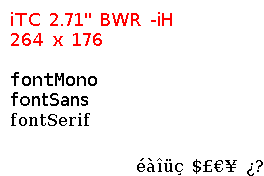Text¶
Configure¶
myScreen.selectFont(fontMax() - 1);
myScreen.setFontSolid(false);
selectFont()- selects the font based on its index, from range
0..fontMax() - 1. setFontSolid()- prints the text on a transparent background for
falseor on an opaque background fortrue.
Use¶
1 2 3 | |
gText()- prints a text at the graphic coordinates.
The required parameters are
- The first line specifies the top-left coordinates
x-y, and the text coded in UTF-8 .
The optional parameters are
- The second and third lines are optional and specify the text and background colours.
Default values are black text on white background.
If the font is not solid, the background is not generated.
The GUI library offers more advanced control with the Text element.
uint16_t sizeI = myScreen.characterSizeX('I');
uint16_t sizeM = myScreen.characterSizeX('M');
characterSizeX()- returns the size of the character on the x-axis.
As some fonts are proportional, a character is required as parameter.
characterSizeY()- returns the size of the font on the y-axis.
uint16_t sizeI = myScreen.stringSizeX("Text");
uint16_t sizeM = myScreen.stringLengthToFitX("Text", 40);
stringSizeX()- returns the size of the string on the x-axis.
stringLengthToFitX()- returns the number of characters to fit a given number of pixels on the x-axis.
Example¶
This is the core of the code from example Common_Fonts.ino.
void displayFonts()
{
uint16_t x = 10;
uint16_t y = 10;
myScreen.setOrientation(myOrientation);
myScreen.selectFont(fontLarge);
myScreen.gText(x, y, myScreen.WhoAmI(), myColours.red);
y += myScreen.characterSizeY();
myScreen.gText(x, y, formatString("%i x %i", myScreen.screenSizeX(), myScreen.screenSizeY()), myColours.red);
y += myScreen.characterSizeY();
y += myScreen.characterSizeY();
myScreen.selectFont(fontSmall);
myScreen.gText(x, y, "Terminal6x8");
y += myScreen.characterSizeY();
myScreen.selectFont(fontMedium);
myScreen.gText(x, y, "Terminal8x12");
y += myScreen.characterSizeY();
myScreen.selectFont(fontLarge);
myScreen.gText(x, y, "Terminal12x16");
y += myScreen.characterSizeY();
myScreen.selectFont(fontVery);
myScreen.gText(x, y, "Terminal16x24");
y += myScreen.characterSizeY();
// Extended
myScreen.selectFont(fontMedium);
#if (STRING_MODE == USE_STRING_OBJECT)
String text = "éàîüç $£€¥ ¿?";
#elif (STRING_MODE == USE_CHAR_ARRAY)
char text[] = "éàîüç $£€¥ ¿?";
#endif // STRING_MODE
uint16_t z = myScreen.stringSizeX(text);
uint16_t t = myScreen.characterSizeY();
myScreen.gText(myScreen.screenSizeX() - z, myScreen.screenSizeY() - t, text);
y += myScreen.characterSizeY();
myScreen.flush();
}
Legacy release 9
Legacy release 9 features the DejaVu font.

Text coded in UTF-8 needs first to be converted into ISO-8859-1 or Latin 1 with utf2iso().
// Prepare text
#if (STRING_MODE == USE_STRING_OBJECT)
String text = utf2iso("éàîüç $£€¥ ¿?");
#elif (STRING_MODE == USE_CHAR_ARRAY)
char text[24];
strcpy(text, utf2iso("éàîüç $£€¥ ¿?"));
#endif // STRING_MODE